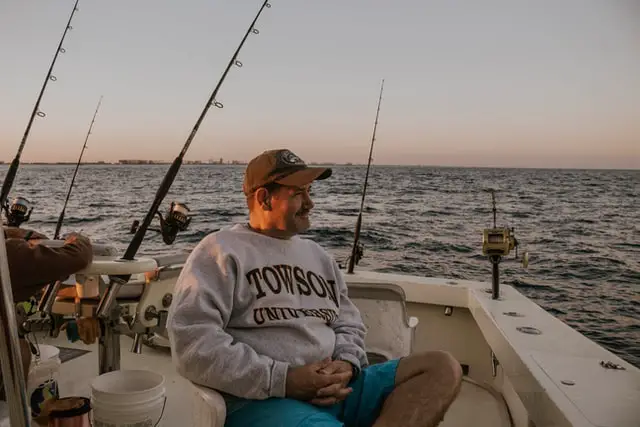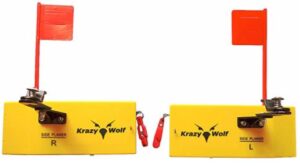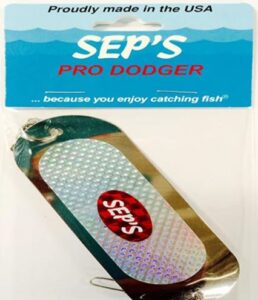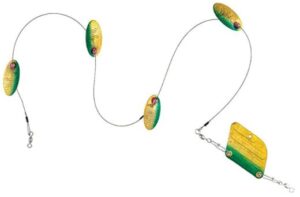Trolling for Trout Without Downriggers

Let me tell you a quick story… After I bought my first boat I thought trolling for trout would be easy. Little did I know, I quickly realized that trolling involved much more than letting a lure coast behind my boat! For the life of me I didn’t catch anything other than a sunburn! I was getting more and more frustrated. To make matters worse, I kept on snagging my baits on the bottom structure.
Then asked my neighbor (who’s also an avid fisherman) about what’s the best way I should be trolling for trout? He introduced me to several trolling concepts, techniques and products that he used when he was fishing Washington for trout, kokanee, salmon and walleye. At that point everything changed… In summary, if you’re going to be trolling for trout (even without downriggers) this is what you need to do:
- Understand how deep you need to troll based on the weather and time of year
- Choose the best device to get the trout’s attention.
- Pick the right rig to get your lure to the depth you want
- And finally, decide on a lure that consistently catches trout
Now, every time I hit the lake I feel comfortable that I’ll be successful no matter what time of year or conditions.
WARNING: There’s a lot of information about this subject you’ll probably want to come back to. No one expects you to remember all these tips. We know your time is precious, so we really tried to over-deliver in value for you. Additionally, we frequently update reports like this, so you’ll want to stay up to date with any changes or additional tips we include for you.
We found that the easiest way to save and bookmark this report so you can come back to it later is to share it on your favorite social media platform, especially if you use your phone to get important tips like the ones in this report here…
Click on your favorite social media buttons to remember this page now!
Key Takeaways
If you don’t have much time to read this detailed report, simply use the links below to quickly find the best helpful products for trout trolling on Amazon. You can be assured we only choose the best products…
Best Flasher – Panther Martin High Lake Fish Attractor With Rudder
Best Dodger – SHASTA TACKLE Sling Blade Dodger
Best Diver – Luhr Jensen Dipsy Diver
Best Spinner – Panther Martin Pro Guide Anywhere 6 Pack
What is the best trolling rig for trout or salmon?
The best way to catch a big trout, kokanee, or salmon is to use the following setup:
Attractor: 6in Shasta Tackle UV sling blade (blue, silver in clear water, chartreuse, bright pink in stained water)
Leader: 18-24-inch leader. The more active the fish are, the shorter the leader you want. The attractor will also shake and wobble the lure as it wobbles back and forth. The longer the leader is, the less action your lure will have.
Lure option #1: Wiggle Hoochie in green, blue, pink, or a Mack’s Criplure. These baits will give you the most action.
Lure option #2: Tie on a Mack’s Peewee Hoochi +/- a Mack’s Smile Blade in front of the Hoochie, wedding ring spinner size 2, in-line spinner, or trolling spoon (like a KastMaster or a Dare Devil spoon). These baits will give you moderate action.
Lure option #3: Tie on a #2 straight shank light wire Neko rig hook (hook that bass anglers will use), then thread on a 1.5-inch Berkley Power Minnow on a size 2 light wire finesse hook behind your sling blade +/- a Macks Smile blade in front of the Hoochi. This bait will give you the least action, which can be great when fishing after a previous cold front, fishing in calm conditions, or if you’re fishing in very clear water!
What to do if you’re not getting bites: (1) small piece of cured anchovy or cured shad to the hook and cover with bait scent. (2) change the lure color based on the water clarity. (3) If water clarity is the same, then change to a lure with either more action (wiggle hoochie) or less action (Berkley Power Minnow on a 24-inch leader). (4) go to a different spot
You’ll have the best results if you troll 1.5-2.0 miles per hour.
Many times trout or salmon will just follow the lure being trolled, sometimes up to 5-10 minutes and not strike! So to create a reaction strike, you want to either speed up or slow down your troll every few minutes. Another good way to get a reaction strike is to make a sharp turn of the boat.
Common items you’ll need for trolling trout...
#ad / Images from Amazon Product Advertising API
Fishing For Lake Trout
Here’s the best initial strategy when you get to the lake…
Start by heading to the deepest coldest part of the lake, normally by the dam
Get your rods set up by rigging up a sling blade attractor to a 18-24-inch fluorocarbon leader tied onto a quality lure like a 1-3/4-inch Mack’s Lure Cripplure Spoon or a Mack’s Peewee Hoochie lure.
Here’s a quick decision table to help you choose the right spoon lure for the right conditions.
Condition | Color |
Clear blue skies | Silver – blue UV fish scale |
Overcast | Brass – neon orange or neon red |
Partially cloudy (light mostly sunny) | Silver – pink or red |
Partially cloudy (light mostly cloudy) | Brass – neon orange or neon red |
If you run multiple spoons, choose different colors first. Then when the trout, salmon, or kokanee start biting a single color simply switch your lures out to that same color after a few bites.
Once you have your spoon chosen it’s strongly recommended you add on some scent like Pro-Cure.
Spoons like these are extremely versatile because they will swim at very slow speeds (as slow as 1.5-mph – ie; during the winter when the water temp is <55-degrees) or fast speeds (2.5-3-mph – ie; during the late spring and summer when the water is 65-69-degrees).
At higher speeds, lures like the Cripplure will swim more erratically and will create a ton of vibration, this means you’ll get a better reaction bite, so you can catch more fish.
Run your lure about 75-100-ft back.
The great thing about using an attractor like the Sling Blade is you can troll up to 4-mph if you don’t bend it. Once you start putting bends in it (to increase the action) then you need to fish it slowly (1.5-2-mph).
In the morning expect to see the fish between 5-20 feet of water.
Then as the sun comes up, they’ll start to hold deeper.
Here's a list of the best selling fish attractors/dodgers for you to consider...
#ad / Images from Amazon Product Advertising API
Here's a list of the best selling fish attractor scents from Pro-Cure for you to consider...
| # | Preview | Product | Rating | |
|---|---|---|---|---|
| 1 |

|
Pro-Cure Trophy Trout Super Gel, 2 Ounce | No ratings yet | Learn More |
| 2 |

|
Pro-Cure Trophy Trout Super Gel, 8 Ounce | No ratings yet | Learn More |
| 3 |

|
Pro Pack Trout is a Perfect Mix of scents to Help Anglers of All Skill Levels Catch More Trout. | No ratings yet | Learn More |
#ad / Images from Amazon Product Advertising API
How Deep to Troll for Trout?
The EASY Way To Effectively TROLL For Trout
Many anglers believe that outriggers are necessary to reach trout when trolling. This is not always the case. During most of the year, trout are well within the range of other methods.
An important point to remember is that trout will not expend more energy than necessary to feed. Even if cruising the lake looking for food, they will select the meal which is easiest to catch. This means that getting your lure as close to where the trout are will increase your success.
If you have fished a lake enough to learn the fish behavior you can start by setting downriggers to depth(s) that were previously successful. Otherwise, you will need to set downriggers as different depths until fish are located, then adjust rigs accordingly.
To save you time here is some general tips for locating trout during each season:
- Spring – cool water will allow trout to be in shallow, nearshore areas. As the trout move about the lake, they will most likely be found in the top of the water column.
- Summer – trout will seek cooler water, moving away from shore and into deeper water. Depending on the species this will be anywhere between 25 – 60ft.
- Fall – cooling temperatures will draw trout back to shallower areas or higher in the water column. They will naturally try to migrate to spawn so focus on the areas near the mouth of rivers or streams.
- Winter – initial drops in temperature cause trout to scatter. There is simply so much water that is comfortable they are no longer confined. Once temperatures stabilize, they follow the bait with most in the 10 – 15 ft. depth.
As you can see, except for summer when temperatures are at the hottest, trout can be found in the upper water columns. This area is easily fished without downriggers. Let us see how.
Flat Line Trolling for Trout (Shallow trolling)
Flies can be used with any trolling method, however, some work better than others. These methods take advantage of a fly’s action and resemblance to natural bait.
Flat Lining
Flat Lining – this is the least complicated method of trolling for trout. It requires no special equipment and can be done from almost any boat, including canoes and kayaks. It is remarkably effective on smaller waters or when trout are running at shallow depths.
- Attach a diving lure such as a deep-diving crankbait, spoon, or spinner to line
- Let out 25-50 ft. of the line while moving at slow speed
- Place the rod in the holder and wait for a bite.
While flat lining may be the easiest method for shallow trolling it is by no means less effective. Plus, despite its simplicity, several advantages make flat lining stand out.
- Allows the user to space out several lines and cover more area
- Does not require expensive, specialized equipment
- Can be done from almost any watercraft including kayaks and jet skies
- Works equally well for a variety of species from lake trout to kokanee
Planers

This method is similar downriggers in that it uses a mast, reel, and secondary line to deploy the planer boards. However, there is no weight and the entire outfit is more compact making it a better choice for smaller boats. It also makes it a good choice for use with smaller lures like flies. The biggest advantage is the ability to space lines further apart, covering a larger search area.
- Attach planer board to mast cable and place in the water
- Feed out cable until the board is desired distance from the boat (20-35 yds)
- Place fly in the water with the drag set
- Attach the release clip to the fishing line and cable ring and place in the water
- Feed fishing line, allowing the ring to slide out the cable until 2-3 ft. from board
- When a fish strikes the clip will release allow fishing line to fall in behind the boat. If a smaller fish strikes and the clip does not release give the fishing line a slight tug.
Dodgers

Dodgers resemble large spoon lures. When used while trolling they add both action and depth, allowing you to target large trout like deeper water. They are available in a wide range of sizes, allowing you to target everything from lake trout to kokanee.
- Attach the dodger to the mainline via a barrel swivel
- Attach 18-inch leader to the opposite end of dodger via a barrel swivel
- Attach lure or fly to the leader
The Lake Troll In-line Flasher

A lake troll consists of a flasher and multiple in-line spinners. This set up combines all the best features of the other methods and presents an offering trout cannot resist. Here is a basic rig, you can mix it up as needed based on local conditions:
- Attach lake troll to the mainline via a barrel swivel
- Attach 30-inch leader to lake troll via a barrel swivel
- Attach action disc and bobber stop
- Attach fly
** If you need to get your line deeper add a keel weight before lake troll. **
How to get Lures Deeper when Trolling
Sometimes you need to get deeper to find the fish. Maybe the water is warmer than usual. Maybe this is where the baitfish are hanging. Whatever the reason you need to increase your depth. But how are you going to do this without downriggers?
Going deeper is easier than you might think. There are also several options, some perfect for adding to your set up on the water.
Changing lures – one of the first methods of fishing deeper is changing your lure. Adding a lure that is designed to dive will naturally fish deeper than a spinner or spoon. Generally, the depth a lure will dive is determined by the bill shape and size. Larger, longer bills will cause the lure to diver deeper. The sharper the pitch the quicker it will diver.
Adding weight– the simplest way to get your bait or lure deeper is to add weight. There are several weights to choose from but two of the most popular are snap weights and keel weights.
Keel weights are attached to your mainline directly in front of your lure. The only way to adjust the amount of weight is to remove one and add another. The benefit of this weight is the shape includes a built-in keel to reduce line twist.
Snap weight can be added or removed as needed so they are good when fishing lakes with different depths. You can easily adjust depth as you fish in different areas. The most common method of applying snap weights is one weight every 50 feet until you reach the desired depth.
How do you know how much weight to add? Most of this involves trial and error but having a logical starting point helps reduce the time it takes to figure out the perfect weight combination.
Trolling Weight-Depth-Speed Ratio Chart
| Weight | 1 mph | 1.5 mph | 2 mph |
|---|---|---|---|
| ½ ounce | 10-14 ft. | 6-10 ft. | 2-6 ft. |
| 1 ounce | 16-20 ft. | 12-16 ft. | 8-12 ft. |
| 1.5 ounces | 20-24 ft. | 16-20 ft. | 12-16 ft. |
| 2 ounces | 22-26 ft. | 18-22 ft. | 14-18 ft. |
| 3 ounces | 28-32 ft. | 24-28 ft. | 20-24 ft. |
*Remember, the faster you go the less depth you will achieve.
Using Diving Device
EASY Way To Effectively TROLL For Trout
diving devices are the most effective means of getting your lure real deep. Some will allow you to get as deep as 90 feet!
There are several models on the market, and everyone has their favorite, but here are some of our favorites.
Dipsy Diver – this is one of the most versatile diver devices and especially useful when fishing multiple lines from a small boat. With an adjustable fin, you can control how each track. The trip release lets the diver float free when fighting a fish to reduce drag.
Depth is controlled by the size of the Dipsy Diver so you may need multiple different ones available. Once you know how it works on your favorite lake with you set up simply repeat during future trips.
Jet Diver – this floating diver allows the angler to control depth by increasing or decreasing speed. When moving it will dive to the bottom. Stop and it will float to the surface. These characteristics make it especially useful when fishing near snags or debris.
Decreased Line Diameter – The diameter (or width) of the line causes your lure to be pulled towards the surface when being trolled. This is why faster speeds result in less depth.
You can counter this, and gain a few extra feet, by reducing your line’s diameter.
Thanks to the modern braided line you can do this without sacrificing strength.
Bonus Tip: Trout Fishing with Leadcore Line
Leadline – using a lead line allows you to reach greater depths without outriggers or accessories. The line itself is the weight which causes it to sink at a predetermined rate. Most lead lines will reach a depth of 30-50 feet regardless of what lure or bait is used.
The line is marked at 10-yard intervals, allowing the angler to know how deep the line is based on the amount of line deployed.
Due to the lead outer sheath using the lead line does require some special techniques. First, attach monofilament backing at 2/3rd the line weight of the lead line used. Next, connect the lead line. 100 yards is plenty. Finally, attach 10-15 yards of monofilament or fluorocarbon leader of the same weight at the backing.
When tying backer or leader to lead line you need to remove the sheath and tie with only the hollow braid core.
Where to Troll for Deep Trout
Before hitting the water, be sure to look at as many maps of the lake as you can. Navionics has a great lake maps software that you can even use on your PC!
If not there, call your local tackle shop and ask if they sell old-school topographic maps of the lake you’re fishing on.
Then look for the following structures and mark them on your map:
- steep shorelines
- bluff walls
- main lake points with deep water nearby
- channel swings close to shore
- string of islands
- long submerged ledges
Then when you get to the lake start your scanning of these areas with a quality fish finder and create a ‘milk-run’, or a game plan of trolling from spot to spot so you can best optimize your time.
You should definitely invest in a quality fishing sonar to scan the surrounding sonar of the lake.
Trout will suspend at different depths near these areas (depending on a variety of conditions) and can be found 30-90 feet from the given structure.
Bluff walls, steep shorelines, and channel swings close to shore are a given that there is deep water nearby.
Long submerged ledges and strings of islands also harbor drop offs and deep water. Make it a point to fish parallel to these areas, not over them.
When is the Best Time to Troll for Deep Trout?
Weather – In early springtime, you’ll have the best luck in the most northern section of the lake. This tends to warm up the quickest and trout seem to feed most aggressively in the early morning at first light to around 10am.
Whereas in the summer, trout you’ll have the easiest time catching trout 45 minutes before and after sunrise and sunset. However, trout will feed all throughout the day if given the opportunity.
Trolling For Trout In The Wind

photo: @ nitish-meena
Windy conditions can make or break your day when you’re trolling.
however sometimes the wind is just too strong, or coming in from the wrong direction. It makes trolling seem more like an unpleasant chore.
Recently I stumbled across a amazing new item that helps me slow my boat while maintaining a ninja silent presentation and keeps my lure in strike zone loner.
This product is called a drift sock!
It’s really easy to use and you attach it to the aft or the side of the boat.
Best of all since its not electric, it doesn’t use up all my battery!
Even if you never used a drift sock before, the job of deploying one is easy once you learn a few basics. If you have no idea what a drift sock is and would like to learn more more – start here… I wrote the complete blueprint report on Drift Sock Basics – What It Is & How To Use It [2021 Quick Start Guide]. Where I go into more detail on What Does A Drift Sock Do and Why Use A Drift Sock?
The drift sock we highly recommend is made a company called Mythik Outdoors. They won the best overall quality award and can be used on the vast majority of boats or kayaks.
The drift sock comes in a complete kit. Meaning, you get a insanely durable drift sock, a floating harness, a collapsing cord and a water resistant storage bag. – It’s really cool.
We you’re interested in this you can read all the reviews from actual Amazon customers. Click here!
Where to troll in windy conditions?
There is some debate on where to troll for deep trout in windy conditions.
Some say, it doesn’t matter where you troll for deep trout because the wind doesn’t have a major effect on their positioning or feeding habits.
On the other hand some anglers say just the opposite. Their argument is the wind is typically warmer than the water and that can not only warm the water (which the trout don’t like), but also deprive that water of oxygen (because warmer water does not have enough oxygen).
Personally, I find that logic slightly flawed.
It would have to be very windy for several days of the same warm conditions and never change direction in order to possibly have the effects of changing the oxygenation of deep water.
Many times wind will change direction and there are high-pressure and low-pressure systems that roll through any given lake where I feel it doesn’t have that much of an effect.
I guess, if you’re struggling at one end of the lake and you’re faced with windy conditions, head over the opposite side of the lake and see if the water temperature is cooler… who knows, it may work!
Rod & Reel Setup for Trout Trolling
Best Rod & Reel for Trolling Lake Trout
Push comes to shove and you can use almost any rod & reel set up for trolling. Anglers have been known to use everything from ultralight tackle to fly rods with success. However, if you are purchasing a rod & reel combination specifically for trolling there are some features that stand out.
- Medium strength, fast tip, 8′-10′
- Sturdy reel with line counter. seat for better control
- Long handle for sturdy hold and leverage.
Here is the list of products featured in the above video...
#ad / Images from Amazon Product Advertising API
Sensitivity is not an issue. You do not need to feel the fish strike. Trade sensitivity for extra durability. This will allow your reel to survive snags, hard strikes and abuse from you lure repeatedly bouncing off the bottom.
Although spinning reels can be used for trolling, they are not the first choice. Instead, invest in a quality baitcasting reel. If you can afford a model with a built-in line counter do it. This will allow you to know exactly how much line is out and where your lure is.
No matter what type of reel you select you will need an extra-large spool. Trolling means letting a lot of line out and a normal spool will cause you to be in your backing before you know it.
Finally, select a quality drag system. It will cost more but it will be worth every penny. Not only do you need the extra drag to battle big fish from deep water you also need to ensure line pays out without hanging up.
Other Trout Trolling Related Articles Just For You...
- How To Troll for Trout [A Beginner’s Guide]
- 10 of the Best Trolling for Rainbow Trout Techniques [Tips Without Downriggers]
- Trolling for Trout with Downriggers (Best Practices & More – Secrets From A Retired Fishing Guide)
- How To Troll Flies For Trout [Our 15 Best Tips]
- What’s The Difference Between Rainbow Trout Vs Steelhead?
FAQ
Can I troll with a spinning reel?
Yes, you can troll with spinning gear. However, spinning gear does bring with it some potential disadvantages. First, make sure you have a large enough spool. Even with a large spool lead line may not be an option. Second, be prepared for increased line twist. Make sure to use swivels and set your drag correctly to reduce twist.
How do I avoid tangling trolling lines when turning?
First, know where your lines are. The biggest reason lines twist is because they are crossed. Second, space your line properly. Using Dipsy Divers or planing boards to help spread line. You can also reduce the number of lines fished. Finally, make slow wide arcing turns. This will prevent lines from crossing each other.
Do I need a depth finder to troll for trout?
No, a depth finder is not required to troll for trout. However, having a depth finder will allow you to target fish more precisely.
Will there be lake trout out in the middle of the lake?
Yes, lake trout often suspend about 40 to 60-feet down. They are usually in close proximity to schools of baitfish. If you are closer to shore in 40 to 60-feet of water and not catching anything, drop your line down to the bottom so you know how deep you are and then leave your rig at that depth and head out into the open water.
In the open water, you will usually catch less trout but they will be bigger. This is not always true. There are occasions where all the trout are out in the open water, especially when the last few days have been hot with a strong wind that keeps changing direction.
































![Mythik Lures Drift Master - Premium Drift Sock for Small Fishing Boat, Pontoon, or Kayak Fishing [Complete Kit Included] - Quality Trolling Bag Used Like A Trolling Plate](https://m.media-amazon.com/images/I/51gWh7BX1mL._SL160_.jpg)